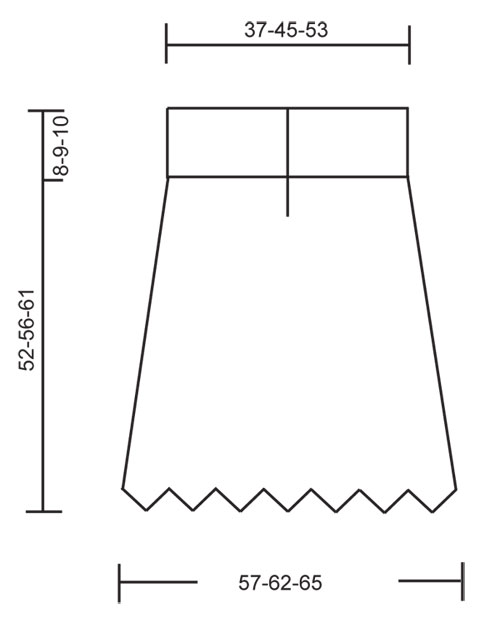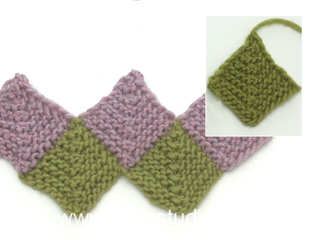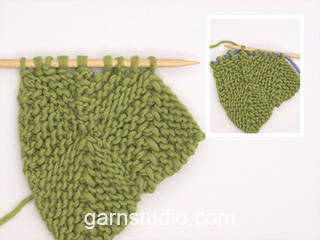Shifting Bricks |
|
|
|
|
Knitted DROPS skirt with Domino squares in ”Delight”. Size S - XXL.
DROPS 121-5 |
|
|
WHOLE DOMINO SQUARE: Row 1 (= from WS): K all sts. Row 2 (= from RS): K row to 1 st before st with marker, slip 1 st as if to K, K2 tog, psso, work remaining sts on row. Repeat row 1 and 2, i.e. dec 2 sts in the middle of square on every other row until there is 1 st left on needle, cut the thread and pull it through the last st. HALF DOMINO SQUARE (vertical) with front band: Row 1 (= from WS): K sts, AT THE SAME TIME dec 2 sts evenly (do not dec on front band). Row 2 (= from RS): K sts on row until 8 sts remain (includes front band), K2 tog, 6 front band sts. Row 3 (= WS): K all sts. Repeat row 2 and 3, i.e. dec 1 st (towards front band) on every other row until there is 1 st (+ 6 front band sts) left on needle. Cut the thread and pull it through the last st. Slip the 6 front band sts on a stitch holder. HALF DOMINO SQUARE (vertical) without front band: Row 1 (= from WS): K sts, AT THE SAME TIME dec 2 sts evenly. Row 2 (= from RS): K2 tog, work remaining sts on row. Row 3 (= WS): K all sts. Repeat row 2 and 3, i.e. dec 1 st on every other row until there is 1 st left on needle. Cut the thread and pull it through the last st. HALF DOMINO SQUARE (horizontal): Work like whole domino square, but in addition to the dec in the middle of square, slip the last st at the end of every row on a stitch holder. Continue until there are 3-5-5 sts left on needle. SIZE S/M: 3 sts left on needle (= 4 sts on stitch holder each side). K 1 row from WS on the 3 sts. Work next row (= from RS) as follows: slip 1 st as if to K, K2 tog, psso. Cut the thread and pull it through the last st. SIZE L/XL + XXL: 5 sts left on needle (= 4-5 sts on stitch holder each side). K 1 row from WS and slip the last st at the end of row on stitch holder. Work next row (from RS) as follows: slip 1 st as if to K, K2 tog, psso. Slip the last st at the end of row on stitch holder (= 5-6 sts on stitch holder each side). Cut the thread and pull it through the last st. BUTTONHOLES: Make buttonholes on front band. 1 buttonhole = bind off 3rd and 4th front band st and cast on 2 new sts on next row. Make buttonholes when front band measures: SIZE S/M: 1, 4, 7, 10 and 13 cm / ½",1½",2 3/4",4" and 5 1/8". SIZE L/XL: 1, 4, 8, 11 and 14 cm / ½",1½",3 1/8",4 3/8" and 5½". SIZE XXL: 1, 4, 8, 12 and 16 cm / ½",1½",3 1/8",4 3/4" and 6 1/4". -------------------------------------------------------- All squares worked in garter st - i.e. K all rows. SKIRT: Beg by casting on sts for the full width of the bottom of skirt, then continue with squares back and forth on circular needle. ROW 1: Cast on 434-462-490 sts on circular needle size 3 mm / US 2or3 with Delight. K 1 row from WS and work next row from RS as follows: K 14-15-16, * slip 1 st as if to K, K2 tog, psso, K 28-30-32 *, repeat from *-* a total of 13 times and finish with slip 1 st as if to K, K2 tog, psso and K 14-15-16 = 406-434-462 sts. Now work WHOLE DOMINO SQUARE - see above. Beg with the first 29-31-33 sts on row. Insert a marker in the middle of the 29-31-33 sts. Continue as described above. When domino square is finished, work in the same way on the next 29-31-33 sts and repeat across the row until there are 14 squares on Row 1. ROW 2: Pick up 14-15-16 sts along the edge on square 1 on Row 1. Then pick up 1 st between the first and the second square, insert a marker in this st, then pick up 14-15-16 sts along the edge on den second square on Row 1 = 29-31-33 sts on needle. Continue with whole domino square. Work in the same way between all squares from Row 1 = 14 domino squares on Row 2. ROW 3: Like row 2. ROW 4: Like row 2. ROW 5: Pick up sts as described for Row 2, but on first row (= from WS) dec 2 sts evenly on all squares = 27-29-31 sts. Continue with whole domino square as before. Work in the same way between all squares from Row 4 = 14 domino squares on Row 5. ROW 6: Pick up 13-14-15 sts along the edge on the first square on Row 5. Then pick up 1 st between the first and the second square, insert a marker in this st, then pick up 13-14-15 sts along the edge on the second square on Row 5 = 27-29-31 sts on needle. Continue with whole domino square. Work in the same way between all squares from Row 5 = 14 domino squares on Row 6. ROW 7: Like row 6. ROW 8: Like row 6. ROW 9: Pick up sts as described for Row 6, but on first row (= from WS) dec 4 sts evenly on all squares = 23-25-27 sts. Continue with whole domino square as before. Work in the same way between all squares from Row 8 = 14 domino squares on Row 9. ROW 10: Pick up 11-12-13 sts along the edge on the first square on Row 9. Then pick up 1 st between the first and the second square, insert a marker in this st, then pick up 11-12-13 sts along the edge on the second square on Row 9 = 23-25-27 sts on needle. Continue with whole domino square. Work in the same way between all squares from Row 9 = 14 domino squares on Row 10. ROW 11: Piece is now to be divided mid back and you knit 2 half squares. Pick up 11-12-13 sts along the edge on the first square and pick up 1 st between the first and the second square on Row 10 = 12-13-14 sts. Then cast on 6 new sts (= front band) = 18-19-20 sts. Continue with half domino square (vertical) with front band - see above. AT THE SAME TIME when front band measures approx 1 cm / ½'', make BUTTONHOLES - see above. When the half square is finished, pick up 1 st between the first and the second square on Row 10. Now pick up 11-12-13 sts along the edge on the second square = 12-13-14 sts. Now work half domino square (vertical) without front band - see above. When the half square is finished continue as follows: Pick up 11-12-13 sts along the other edge on second square on Row 10. Then pick up 1 st between the second and the third square, insert a marker in this st, then pick up 11-12-13 sts along the edge on den third square on Row 10 = 23-25-27 sts on needle. Continue with whole domino square, but on row 1 (= from WS) dec 4-4-2 sts evenly = 19-21-25 sts. Continue with whole domino square as before. Work in the same way between all the squares from Row 10 = 13 whole domino squares and 2 half domino squares on Row 11. ROW 12: Pick up 9-10-12 sts along the edge on the second half square from Row 11. Then pick up 1 st between the half and the whole square, insert a marker in this st, then pick up 9-10-12 sts along the edge on the whole square = 19-21-25 sts. Work half domino square (horizontal) - see above. Work in the same way between all squares from Row 11 = 14 half domino squares on Row 12. WAIST BAND: Beg from RS on the right side of piece on the first half domino square on Row 12, and work row as follows: * work sts from stitch holder (= 4-5-6 sts) back on needle, pick up 3 sts between stitch holders, work sts from the second stitch holder (= 4-5-6 sts) back on needle, pick up 1 st between squares *, repeat from *-* and finish by working the 6 front bands sts back on needle = 174-202-230 sts. K 1 row from WS. K 1 row from RS, AT THE SAME TIME inc 15-25-35 sts evenly = 189-227-265 sts. Continue back and forth on needle (NOTE! remember to make buttonholes on front band) until waist band measures approx 6-7-8 cm / 2½"-2 3/4"-3". On next row from RS dec 5 sts evenly (do not dec on front band) = 184-222-260 sts. Continue until waist band measures approx 8-9-10 cm / 3"-3½"-4". Bind off. ASSEMBLY: Sew on buttons. |
|

|
|
|
Have you made this or any other of our designs? Tag your pictures in social media with #dropsdesign so we can see them! Do you need help with this pattern?You'll find tutorial videos, a Comments/Questions area and more by visiting the pattern on garnstudio.com. © 1982-2024 DROPS Design A/S. We reserve all rights. This document, including all its sub-sections, has copyrights. Read more about what you can do with our patterns at the bottom of each pattern on our site. |






































Comments / Questions (50)
I'm struggling with Row 11 and the creation of the front band. What do the created stitches from the half square in Row 11 provide when picking up the stitches for the front band? I will need to do decreases, rather than increases as stated, to make the skirt fit. As I don't understand the point of these extra 6 stitches from row 11, I don't know if I can omit them without some issue. This is my first skirt and never done a waistband before. Thanks!
09.07.2023 - 15:38DROPS Design answered:
Dear Sara, the front band stitches create a certain pattern and is used for the HALF DOMINO SQUARE with front band motif. This is necessary to make the band for the buttonholes. If you remove the stitches for the front band then you won't have a specific space for adding the buttonholes to the piece. Happy knitting!
10.07.2023 - 17:58Can't wait to make this! i want to buy a patch skirt, or a peasant skirt. the price is outrageous! i have this urge to make or knit a harlequin skirt. this will do the job. thank you i used to go to tivioli and watch the harlequin and the baker and it's coming back now. i was a child then, thank you. can't wait to knit it.
03.10.2019 - 06:36Vielen Dank für die rasche Antwort! Das erklärt alles. Den Spaß beim Stricken hab ich - zumal jetzt ja das Ende schon absehbar ist... :-)
17.01.2019 - 17:36(Fortsetzung) Aber mit 11 R. (R. 12 sind ja nur halbe E. und gibt keine Höhe mehr), kommt man doch nicht auf 52 cm... Kann es sein, dass da ein Fehler ist?
17.01.2019 - 08:57DROPS Design answered:
siehe Antwort unten.
17.01.2019 - 09:36Obwohl die Maschenprobe exakt gepasst hat, erreiche ich mit 12 Runden Dominoecken nicht die 52 cm aus der Maßskizze, sondern nur ca. 45 cm. Das Verhältnis Länge/Breite macht das auch plausibel: Die Breite von 7 Ecken unten entspr. 57 cm: Dann müssten 7 E. übereinander (also 14 R.!) auch 57 cm entsprechen, bzw. (weil die E. kleiner werden) vielleicht 52 cm. (Fortsetzung folgt...)
17.01.2019 - 08:57DROPS Design answered:
Liebe Johanna, die 52 cm in der Maßskizze sind die gesamte Höhe vom Rock, dh 44 cm von den Dominoquadraten + 8 cm für den Bund. Viel Spaß beim stricken!
17.01.2019 - 09:36Sehe ich das richtig, dass die Bundweite bei Größe S/M etwa 74 cm und bei L/XL etwa 90 cm beträgt? - Da bin ich mit meiner Konfektionsgröße 40 wohl eher bei S/M, weil der Bund wahrscheinlich eher ausleiert, als dass er enger wird... Dann muss ich vielleicht mal noch überlegen, wie ich kreativ die Länge ein wenig anpasse... Oder habe ich irgendwo einen Denkfehler in meiner Überlegung?
28.11.2018 - 23:50DROPS Design answered:
Liebe Johanna, Sie sind ja richtig, Umfang wird bei dem Bund 74 cm in der 1. Größe, 90 cm in der 2. Größe und 106 cm bei der 3. Größe. Hier lesen Sie mehr über die Maßskizze. Viel Spaß beim stricken!
29.11.2018 - 09:58Ich würde den Rock gerne etwas länger haben, geht das so einfach oder muss ich da was besonderes beachten?
16.09.2018 - 14:59DROPS Design answered:
Liebe LIesel, leider können wir nich jede Anleitung nach jedem individuellen Anfrage anpassen, Sie können aber gerne Kontakt mit Ihrem DROPS Laden aufnehmen, Sie werden Ihnen weiterhelfen - auch telefonisch oder per E-Mail. Viel Spaß beim stricken!
17.09.2018 - 09:17Shasha wrote:
Hi! how would I make this skirt in a bigger size? how should I adjust the pattern? I hope it's possible this pattern is lovely!
08.04.2018 - 01:10DROPS Design answered:
Dear Shasha, we are unfortunately not able to adapt every single pattern to each individual request. Please feel free to contact the store where you bought the yarn for any further assistance - even per mail or telephone. Happy knitting!
09.04.2018 - 13:33Er det slik å forstå at den 14.ruten på Rad2 strikkes over 14. og 1. rute på Rad1, slik at man da strikker rundt, og ikke må sy sammen skjørtet etterpå?
15.07.2015 - 15:39DROPS Design answered:
Hei Charlotte. Ja, firkanterne selv strikkes frem og tilbage, men firkanterne strikkes rundt, der kommer ingen söm ved firkanterne.
07.08.2015 - 14:54Hallo liebes Drops Team, ich finde diesen Rock ganz toll, aber wie viele Maschen schlage ich pro Viereck an? Ich weiß nur, dass man bei diesen Dominoecken eine ungerade Maschenzahl braucht. Gruß, Ursel
21.05.2015 - 10:36DROPS Design answered:
Die Anleitung beginnt unter der gestrichelten Linie bei "ROCK", dort finden Sie auch die Angaben zum Maschenanschlag und wie Sie die Maschen, die Sie zunächst für den gesamten Rockumfang anschlagen, auf die einzelnen Vierecke aufteilen. Es sind am Anfang 29-31-33 M pro Viereck, später werden es mit den Abnahmen dann weniger, das sehen Sie dann bei der jeweiligen Runde (in der 5. "Runde" erfolgen die ersten Abnahmen).
21.05.2015 - 11:00